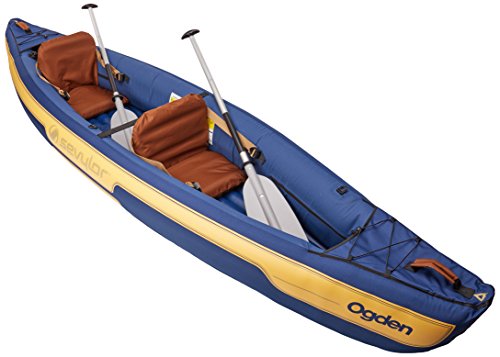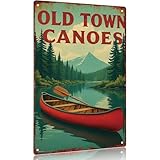Let’s face it; canoes are heavy; canoes are so heavy that many of them come with their own carrying system – the yoke. Supposedly this makes them more comfortable to portage with, but tell that to the person that has a hundred-pound boat perched on their shoulders.
So what is the best small and lightweight canoe? In my opinion, the Next from Old Town has most of the competition beat. At a mere 58 lb and 13 feet in length, the Next is fairly similar to a touring kayak in its size and maneuverability. One person can haul this boat pretty easily, which is good because it only holds one paddler. It’s a solo canoe, and while that’s going to be off-putting to a lot of people that are looking at canoeing as a shared activity for them and a loved one, getting a solo canoe is really the only way to shave a significant number of pounds.
That being said, there are a few other models worth looking at, especially if solo paddling isn’t your idea of a good time. Lightweight construction and going bare bones with the accessories can keep the weight down too. It pays to do your research before making the purchase and to ensure that the canoe still has all the features you need; that’s where I come in. The buying tips and reviews below will help you to make a more informed decision with your first small and/or lightweight canoe purchase.
Last update on 2025-11-27 / Affiliate links / Images from Amazon Product Advertising API
Reviews of the Best Small & Lightweight Canoes
1. Old Town Next Canoe
Old Town is probably the biggest manufacturer of canoes in the world. If you imagine a trip through the wilderness of northern Maine or Minnesota’s Boundary Waters, you almost certainly pictured doing it in an Old Town, and probably one with their classic green paint job to boot.
However, just because their designs are timeless doesn’t mean the company can’t value innovation. The Next is a perfect example of this – a very lightweight solo canoe with a full
The Next weighs just 58 lb so you should have no trouble hauling it around or taking it off a roof rack. Just because it’s light doesn’t mean it’s lacking in capacity though, as it can still carry up to 450 lb of paddler and gear. Not bad for a boat you can carry on your shoulder.
In addition to carrying like a kayak, the Next also paddles like a kayak. The comfortable
One of the major disadvantages of the Next is that it has a flat hull, similar to a recreational kayak. Combined with its shorter than average length, the flat hull diminishes tracking and makes it harder to paddle over long distances.
Also, as would be expected with such a bare design, the Next doesn’t have any accessories to mention. If you want to add anything like a rod holder or fish finder mount, you’ll need to do it yourself.
Even though it doesn’t paddle as straight of a line as most canoes or have any have add-ons, the Next is still the best canoe if having a small and lightweight canoe is a priority for you.
Pros:
- As light as a kayak
- Fully adjustable, backrested seat
- Still has a fairly large capacity
Cons:
- Can only carry one paddler
- Flat hull makes tracking difficult
- No accessories
2. Sevylor Ogden 2-Person Canoe Combo
In recommending this I’ll need to expand the definition of what a canoe is, because the Ogden from Sevylor is a two-person inflatable canoe. While most paddlers accept the idea of an inflatable kayak, an inflatable canoe sounds a bit… out there. Perhaps that’s due to our assumption that canoes are never compact and lightweight in the first place.
The inflatable canoe weighs a paltry 27 lb, less than a third of what most two-person canoes do. Constructed from thick PVC, it’s designed to take a beating, but don’t think that it’s as durable as your standard hardshell.
It’s best to avoid beaching it before entry or exit as sharp rocks can lead to punctures. The lightweight design also has the disadvantage of limited capacity, which is around 370 lb – not even enough for two burly paddlers.
There’s also the issue of setting it up; it takes a few minutes to get this boat pumped up and ready for the water. However, you could also argue that it takes less effort to move between your vehicle and the put-in point so the extra effort for setup is probably a wash compared to conventional canoes.
However, the Ogden costs about a third of what most lightweight canoes do. That’s a great selling point if you’re trying out the sport or don’t see yourself using the canoe all that often.
The Ogden is certainly a different kind of canoe, but if you can get past the durability issues and don’t mind sitting on an inflatable seat, it is truly the most lightweight tandem canoe on the market.
Pros:
- Extremely lightweight
- Built for two
- Inexpensive
Cons:
- More susceptible to damage
- Low weight capacity
- Requires setup
3. Old Town Discovery 119 Solo Sportsman Canoe
Being the prolific canoe manufacturers that they are, it should come as no surprise that Old Town has another model on the list. The Discovery 199 Solo Sportsman is a bit lighter than the Next at 49 lb and is a little more than a foot shorter in length. Surprisingly though, it has a weight capacity that’s 50 lb higher thanks to a very wide center section.
The bulbous center of the Discovery can make it harder to maneuver, as more water needs to be pushed out of the way on a turn. However, the biggest disadvantages of the Discovery compared to the Next are all related to comfort.
The Discovery has only a nylon web seat, with no backrest, and no foot pedals to keep you locked into the paddling position. This results in a weaker paddle stroke and makes it more difficult to use on long-distance trips. However, it does have a much more streamlined hull design, which helps it to track a bit better than the Next.
The Discovery is a solid choice if you need a hardshell canoe and would prefer it paddle like a canoe. It isn’t as comfortable as the Next but can carry more and take a straight line somewhat better.
Pros:
- Lighter than the Old Town Next
- Moderately good tracking
- Huge weight capacity for its length
Cons:
- Uncomfortable seat
- No foot pedals
- Hard to maneuver
How to Choose the Best Small and Lightweight Canoe – Buyer’s Guide
Hauling a canoe will never be a pleasant experience, but that doesn’t mean you should throw up your hands in defeat and purchase the heaviest aluminum canoe at the store. There are options, and some are most certainly lighter than others.
Choosing a lightweight canoe isn’t all that different from picking any other canoe model, but you’ll likely need to make some tradeoffs. Small canoes might have a lower weight capacity or less durability or a lack of creature comforts. It’s up for you to decide what things you’re willing to sacrifice in the name of having a boat that isn’t a hassle to carry.
What is Considered Lightweight for a Canoe
For our purposes, we’ll say that a lightweight canoe is one that weighs less than sixty pounds – which is about average for a kayak and on the lower end for a tandem model. It’s also about all you can comfortably carry by yourself.
But if a lightweight canoe is so much like a kayak, why bother getting a canoe at all? Well, if you’re doing a lot of portaging or taking your boat on a camping trip, nothing is more annoying than emptying out the hull of a kayak. It’s precious time wasted, and if you instead go with a sit-on-top model, everything will end up soaked that’s not sealed away in a day bag.
What Can a Lightweight Canoe Do
You’d think the answer would be obvious – a canoe can paddle! But when considering a lightweight canoe, you might need to rethink what your canoe is for.
Many people choose canoes for fishing because everything is close at hand. Lightweight canoes usually don’t have a lot of accessories though (rod holders, trolling motor mounts, etc.).
Some people choose canoes for their durability – think of how many times you’ve seen someone dragging a canoe overland. Well, lightweight canoes are more fragile, and won’t last very long if they’re not treated with care. But if you’re looking at a lightweight canoe because you like the open-top design and want to carry a lot of gear, this could be the right kind of boat for you.
Do I Have to Paddle Alone?
Admittedly, most lightweight canoes are built for just one paddler. The extra length and seat just add too many pounds to be considered a lightweight canoe. However, most paddlers that are looking to cut weight are doing so because they need a boat that can be carried solo.
Getting a full-sized canoe off the roof of a car and over to the put-in point is a near impossibility without a second set of hands or a cart. So if you know that you’ll consistently have a paddling partner, it’s probably a better idea to just go with a heavier and larger canoe.
My Choice for the Best Small & Lightweight Canoe
There are a number of great options when you’re buying a small and lightweight canoe, but I stand by the Old Town Next as an overall best pick.
It’s as light as any touring kayak, has enough length to give you adequate storage, and one of the most comfortable seats you’ll ever find on a canoe. While other boats might be lighter or have more carrying capacity, the Next strikes a good balance between all the features.
Top Rated Canoes
Last update on 2025-11-12 / Affiliate links / Images from Amazon Product Advertising API










